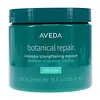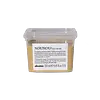What's inside
What's inside
 Key Ingredients
Key Ingredients

 Benefits
Benefits

 Concerns
Concerns

 Ingredients Side-by-side
Ingredients Side-by-side

Water
Skin ConditioningCetearyl Alcohol
EmollientStearamidopropyl Dimethylamine
EmulsifyingBehentrimonium Methosulfate
Dicetyldimonium Chloride
EmulsifyingPersea Gratissima Oil
Skin ConditioningPlukenetia Volubilis Seed Oil
EmollientCamellia Oleifera Seed Oil
Skin ConditioningButyrospermum Parkii Butter
Skin ConditioningCocos Nucifera Oil
MaskingHelianthus Annuus Seed Oil
EmollientEuphorbia Cerifera Wax
Behenyl/Octyldodecyl Propanediol Citrate Crosspolymer
Skin ConditioningOctyldodecyl Citrate Crosspolymer
HumectantHydroxypropylammonium Gluconate
HumectantHydroxypropylgluconamide
HumectantIsostearyl Ethylimidazolinium Ethosulfate
Tocopherol
AntioxidantPropanediol
SolventLactic Acid
BufferingTricaprylyl Citrate
EmollientHeptyl Undecylenate
EmollientCetyl Hydroxyethylcellulose
Emulsion StabilisingSqualane
EmollientIsopropyl Alcohol
SolventCetrimonium Chloride
AntimicrobialParfum
MaskingAmyl Cinnamal
PerfumingCitral
PerfumingGeraniol
PerfumingCitronellol
PerfumingBenzyl Salicylate
PerfumingBenzyl Benzoate
AntimicrobialLinalool
PerfumingHydroxycitronellal
PerfumingLimonene
PerfumingBenzyl Alcohol
PerfumingTartaric Acid
BufferingSodium Benzoate
MaskingCaprylyl Glycol
EmollientPotassium Sorbate
PreservativePhenoxyethanol
PreservativeWater, Cetearyl Alcohol, Stearamidopropyl Dimethylamine, Behentrimonium Methosulfate, Dicetyldimonium Chloride, Persea Gratissima Oil, Plukenetia Volubilis Seed Oil, Camellia Oleifera Seed Oil, Butyrospermum Parkii Butter, Cocos Nucifera Oil, Helianthus Annuus Seed Oil, Euphorbia Cerifera Wax, Behenyl/Octyldodecyl Propanediol Citrate Crosspolymer, Octyldodecyl Citrate Crosspolymer, Hydroxypropylammonium Gluconate, Hydroxypropylgluconamide, Isostearyl Ethylimidazolinium Ethosulfate, Tocopherol, Propanediol, Lactic Acid, Tricaprylyl Citrate, Heptyl Undecylenate, Cetyl Hydroxyethylcellulose, Squalane, Isopropyl Alcohol, Cetrimonium Chloride, Parfum, Amyl Cinnamal, Citral, Geraniol, Citronellol, Benzyl Salicylate, Benzyl Benzoate, Linalool, Hydroxycitronellal, Limonene, Benzyl Alcohol, Tartaric Acid, Sodium Benzoate, Caprylyl Glycol, Potassium Sorbate, Phenoxyethanol
Water
Skin ConditioningGlycerin
HumectantCetearyl Alcohol
EmollientPropanediol
SolventBehentrimonium Chloride
PreservativeCetrimonium Chloride
AntimicrobialCetyl Alcohol
EmollientDimethicone
EmollientGlyceryl Stearate
EmollientBehenyl Alcohol
EmollientBenzotriazolyl Dodecyl P-Cresol
UV AbsorberBeheneth-25
CleansingParfum
MaskingBenzyl Alcohol
PerfumingSimmondsia Chinensis Seed Oil
EmollientOlea Europaea Fruit Oil
MaskingAmodimethicone
Dicaprylyl Ether
EmollientLauryl Alcohol
EmollientOctadecyl Di-T-Butyl-4-Hydroxyhydrocinnamate
AntioxidantHydroxyethylcellulose
Emulsion StabilisingDisodium EDTA
Sodium Benzoate
MaskingCitric Acid
BufferingHydrogenated Olive Oil
Skin ConditioningTocopherol
AntioxidantSolanum Lycopersicum Fruit Extract
AntioxidantSclerotium Gum
Emulsion StabilisingDisiloxane
Skin ConditioningLinalool
PerfumingGeraniol
PerfumingLimonene
PerfumingCI 19140
Cosmetic ColorantCI 14700
Cosmetic ColorantCI 61570
Cosmetic ColorantWater, Glycerin, Cetearyl Alcohol, Propanediol, Behentrimonium Chloride, Cetrimonium Chloride, Cetyl Alcohol, Dimethicone, Glyceryl Stearate, Behenyl Alcohol, Benzotriazolyl Dodecyl P-Cresol, Beheneth-25, Parfum, Benzyl Alcohol, Simmondsia Chinensis Seed Oil, Olea Europaea Fruit Oil, Amodimethicone, Dicaprylyl Ether, Lauryl Alcohol, Octadecyl Di-T-Butyl-4-Hydroxyhydrocinnamate, Hydroxyethylcellulose, Disodium EDTA, Sodium Benzoate, Citric Acid, Hydrogenated Olive Oil, Tocopherol, Solanum Lycopersicum Fruit Extract, Sclerotium Gum, Disiloxane, Linalool, Geraniol, Limonene, CI 19140, CI 14700, CI 61570
 Reviews
Reviews

Ingredients Explained
These ingredients are found in both products.
Ingredients higher up in an ingredient list are typically present in a larger amount.
Benzyl Alcohol is most commonly used as a preservative. It also has a subtle, sweet smell. Small amounts of Benzyl Alcohol is not irritating and safe to use in skincare products. Most Benzyl Alcohol is derived from fruits such as apricots.
Benzyl Alcohol has both antibacterial and antioxidant properties. These properties help lengthen the shelf life of products. Benzyl Alcohol is a solvent and helps dissolve other ingredients. It can also improve the texture and spreadability.
Alcohol comes in many different forms. Different types of alcohol will have different effects on skin. This ingredient is an astringent alcohol.
Using high concentrations of these alcohols are drying on the skin. They may strip away your skin's natural oils and even damage your skin barrier. Astringent alcohols may also irritate skin.
Other types of astringent alcohols include:
According to the National Rosacea Society based in the US, you should be mindful of products with these alcohols in the top half of ingredients.
Any type of sanitizing product will have high amounts of alcohol to help kill bacteria and viruses.
Learn more about Benzyl AlcoholCetearyl alcohol is a mixture of two fatty alcohols: cetyl alcohol and stearyl alcohol. It is mainly used as an emulsifier. Emulsifiers help prevent the separation of oils and products. Due to its composition, it can also be used to thicken a product or help create foam.
Cetearyl alcohol is an emollient. Emollients help soothe and hydrate the skin by trapping moisture.
Studies show Cetearyl alcohol is non-toxic and non-irritating. The FDA allows products labeled "alcohol-free" to have fatty alcohols.
This ingredient is usually derived from plant oils such as palm, vegetable, or coconut oils. There is debate on whether this ingredient will cause acne.
Due to the fatty acid base, this ingredient may not be Malassezia folliculitis safe.
Learn more about Cetearyl AlcoholThis ingredient is a preservative, antimicrobial, and emulsifier. It is often used in cosmetics for its ability to cleanse, condition, and reduce static.
Cetrimonium chloride is a quaternary ammonium salt, meaning it has a water-soluble structure.
Geraniol is used to add fragrance/parfum to a product. It is the main component of citronellol. It is a monoterpenoid and an alcohol.
Monoterpenes are naturally found in many parts of different plants.
Geraniol can be found in many essential oils including Rose Oil and Citronella Oil. The scent of Geraniol is often described as "rose-like". Many foods also contain Geraniol for fruit flavoring.
Geraniol can irritate the skin when exposed to air. However, irritation depends on the ability of geraniol to penetrate into the skin. In general, geraniol is not able to penetrate skin easily.
Geraniol is colorless and has low water-solubility. However, it is soluble in common organic solvents.
Like citronellol, it is a natural insect repellent.
2,6-Octadien-1-ol, 3,7-dimethyl-, (2E)-
Learn more about GeraniolLimonene is a fragrance that adds scent and taste to a formulation.
It's found in the peel oil of citrus fruits and other plants such as lavender and eucalyptus. The scent of limonene is generally described as "sweet citrus".
Limonene acts as an antioxidant, meaning it helps neutralize free radicals.
When exposed to air, oxidized limonene may sensitize the skin. Because of this, limonene is often avoided by people with sensitive skin.
The term 'fragrance' is not regulated in many countries. In many cases, it is up to the brand to define this term. For instance, many brands choose to label themselves as "fragrance-free" because they are not using synthetic fragrances. However, their products may still contain ingredients such as essential oils that are considered a fragrance.
Learn more about LimoneneLinalool is a fragrance and helps add scent to products. It's derived from common plants such as cinnamon, mint, citrus, and lavender.
Like Limonene, this ingredient oxidizes when exposed to air. Oxidized linalool can cause allergies and skin sensitivity.
This ingredient has a scent that is floral, spicy tropical, and citrus-like.
Learn more about LinaloolParfum is a catch-all term for an ingredient or more that is used to give a scent to products.
Also called "fragrance", this ingredient can be a blend of hundreds of chemicals or plant oils. This means every product with "fragrance" or "parfum" in the ingredients list is a different mixture.
For instance, Habanolide is a proprietary trade name for a specific aroma chemical. When used as a fragrance ingredient in cosmetics, most aroma chemicals fall under the broad labeling category of “FRAGRANCE” or “PARFUM” according to EU and US regulations.
The term 'parfum' or 'fragrance' is not regulated in many countries. In many cases, it is up to the brand to define this term.
For instance, many brands choose to label themselves as "fragrance-free" because they are not using synthetic fragrances. However, their products may still contain ingredients such as essential oils that are considered a fragrance by INCI standards.
One example is Calendula flower extract. Calendula is an essential oil that still imparts a scent or 'fragrance'.
Depending on the blend, the ingredients in the mixture can cause allergies and sensitivities on the skin. Some ingredients that are known EU allergens include linalool and citronellol.
Parfum can also be used to mask or cover an unpleasant scent.
The bottom line is: not all fragrances/parfum/ingredients are created equally. If you are worried about fragrances, we recommend taking a closer look at an ingredient. And of course, we always recommend speaking with a professional.
Learn more about ParfumPropanediol is an all-star ingredient. It softens, hydrates, and smooths the skin.
It’s often used to:
Propanediol is not likely to cause sensitivity and considered safe to use. It is derived from corn or petroleum with a clear color and no scent.
Learn more about PropanediolSodium Benzoate is a preservative. It's used in both cosmetic and food products to inhibit the growth of mold and bacteria. It is typically produced synthetically.
Both the US FDA and EU Health Committee have approved the use of sodium benzoate. In the US, levels of 0.1% (of the total product) are allowed.
Sodium benzoate works as a preservative by inhibiting the growth of bacteria inside of cells. It prevents the cell from fermenting a type of sugar using an enzyme called phosphofructokinase.
It is the salt of benzoic acid. Foods containing sodium benzoate include soda, salad dressings, condiments, fruit juices, wines, and snack foods.
Studies for using ascorbic acid and sodium benzoate in cosmetics are lacking, especially in skincare routines with multiple steps.
We always recommend speaking with a professional, such as a dermatologist, if you have any concerns.
Learn more about Sodium BenzoateTocopherol (also known as Vitamin E) is a common antioxidant used to help protect the skin from free-radicals and strengthen the skin barrier. It's also fat soluble - this means our skin is great at absorbing it.
Vitamin E also helps keep your natural skin lipids healthy. Your lipid skin barrier naturally consists of lipids, ceramides, and fatty acids. Vitamin E offers extra protection for your skin’s lipid barrier, keeping your skin healthy and nourished.
Another benefit is a bit of UV protection. Vitamin E helps reduce the damage caused by UVB rays. (It should not replace your sunscreen). Combining it with Vitamin C can decrease sunburned cells and hyperpigmentation after UV exposure.
You might have noticed Vitamin E + C often paired together. This is because it is great at stabilizing Vitamin C. Using the two together helps increase the effectiveness of both ingredients.
There are often claims that Vitamin E can reduce/prevent scarring, but these claims haven't been confirmed by scientific research.
Learn more about TocopherolWater. It's the most common cosmetic ingredient of all. You'll usually see it at the top of ingredient lists, meaning that it makes up the largest part of the product.
So why is it so popular? Water most often acts as a solvent - this means that it helps dissolve other ingredients into the formulation.
You'll also recognize water as that liquid we all need to stay alive. If you see this, drink a glass of water. Stay hydrated!
Learn more about Water